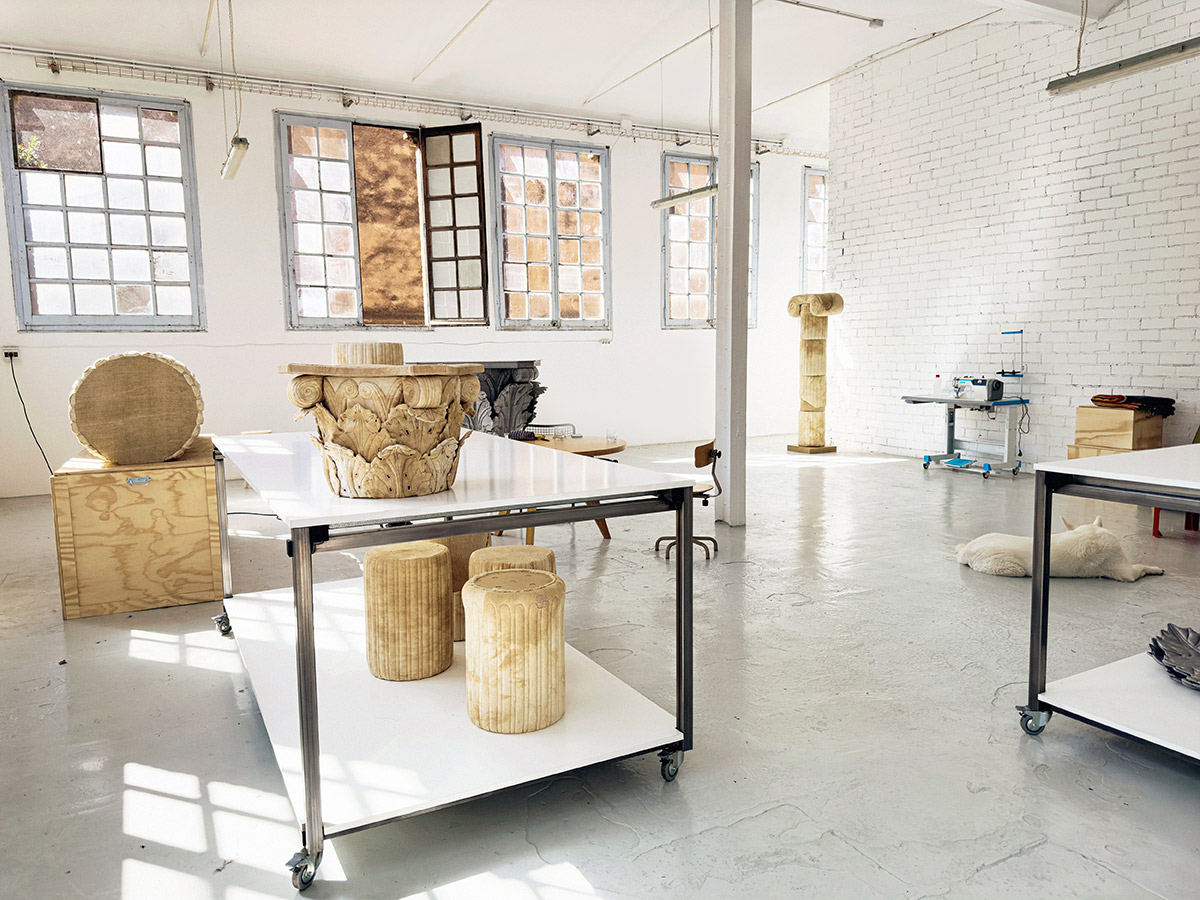Sergio Roger
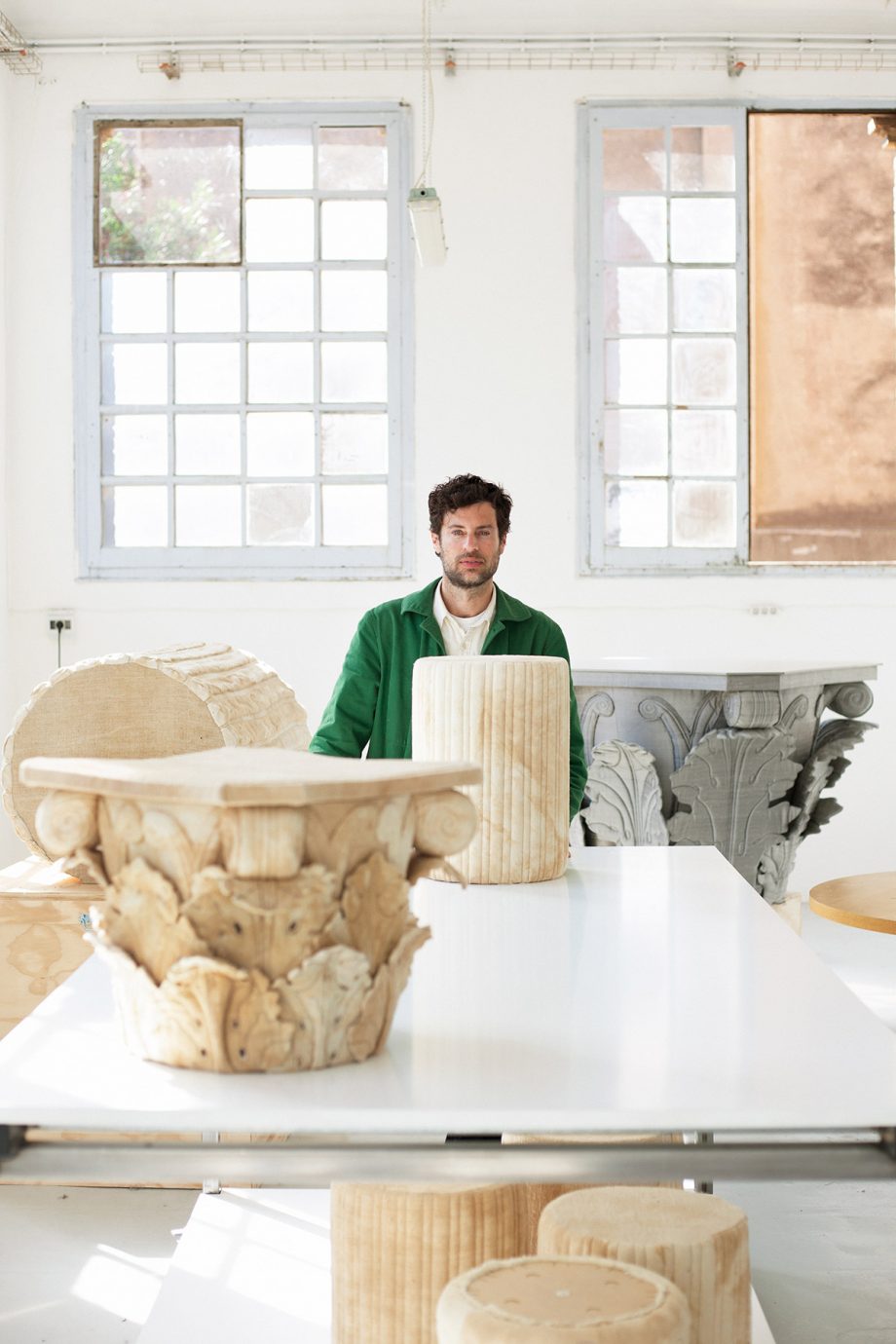
THE ART OF WEAVING STORIES AMIDST THREADS AND RUINS
WORDS AND INTERVIEW TXARLI A DOMENECH PHOTOGRAPHY BY MANOLO DA COSTA LOCATION MOLINS DE REI. SERGIO ROGER WWW.SERGIOROGER.COM @SERGIOROGER
Immersed in the timeless charm of Antiquity, Sergio Roger, a textile artist based in Barcelona, welcomes us to his new studio on the outskirts of Barcelona, housed in an old textile factory, as it could be no other way. Through his work, he invites us to explore the timeless beauty of history, to witness how threads and fibres become storytellers of forgotten eras.
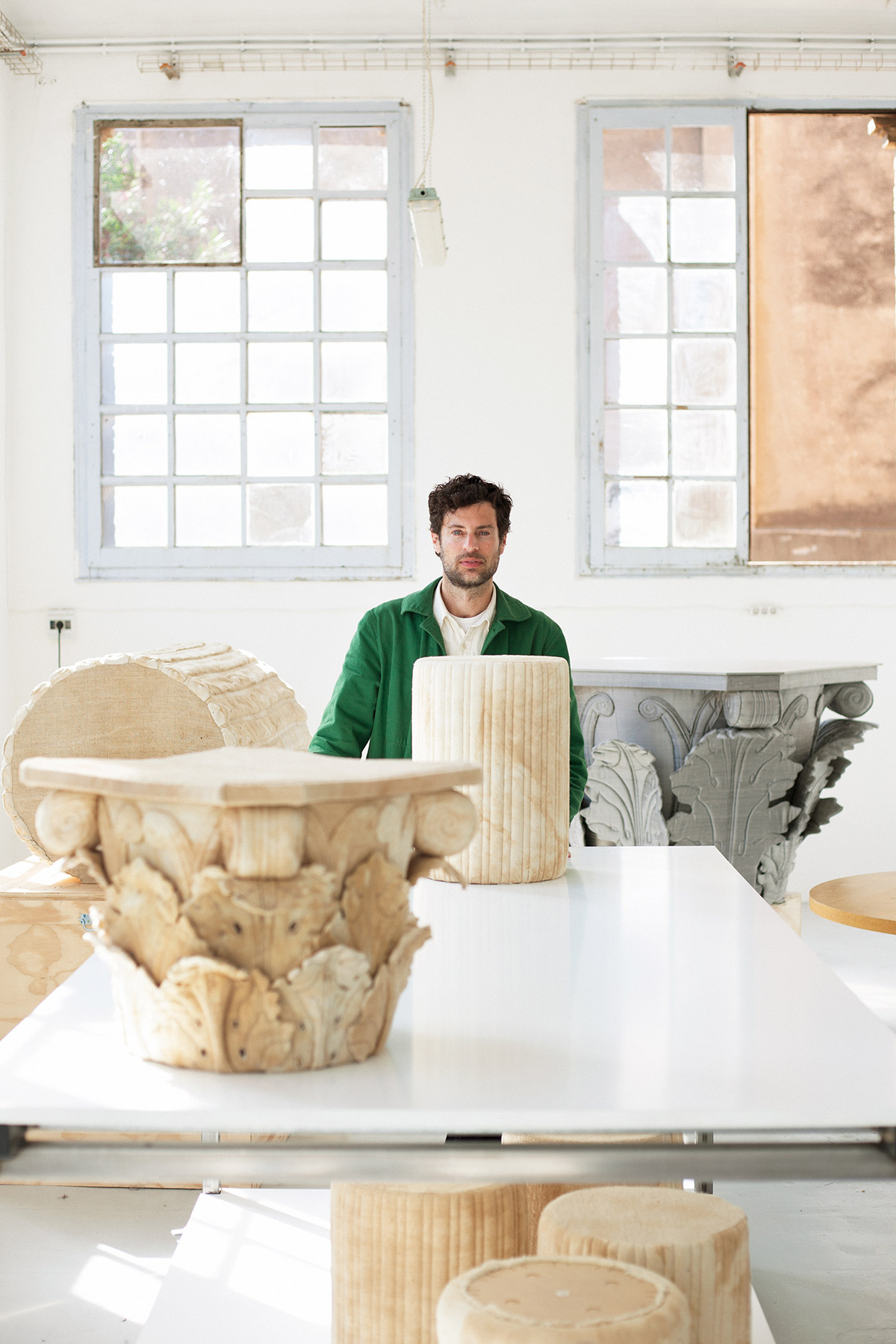
His creations are more than soft sculptures; they are gateways to the past, windows to the emotion and ingenuity of Antiquity. The scale of his work is comprehensive, and the sensitivity he infuses into each of his sculptures is palpable. Each piece by Sergio Roger is a testament to his genuine talent, his ability to create beauty and emotion, turning each piece into a work of high fashion. With needle in hand and a unique vision, Sergio weaves stories that unfold like a tapestry of emotions.
Looking at your bio a bit, you completed a degree in Fine Arts and then went to Berlin to study sculpture, specialising in new media and video art. When I see your work, it makes me think of the age-old existential question: which came first, the chicken or the egg? In your case, what came first, sewing or modelling?
Let’s say that from a very young age, I started sewing. At 13 or 14, I already felt a special affinity for fabrics and their textures, but never with a focus on clothing or fashion. I learned how to hand stitch all kind of stuffed characters. It didn’t take me long to buy a sewing machine to expand my creative horizons. I began to discover contemporary artists who worked with textiles, such as Louise Bourgeois, Joseph Beuys, or the Portuguese artist Joana Vasconcelos, and that’s when I felt that what I saw in those artists aligned well with my passion for textiles. It was right at that moment when I started studying Fine Arts. Even back then, many of my artistic proposals in university revolved around this material, soft sculptures.
In Berlin, the academic system is different from Spain, and it involves more group work with an established artist-professor. That’s when I started incorporating video, but without leaving behind textiles. I made soft masks with protrusions and explored some crazier things, but always with fabrics or other soft materials. When I returned to Barcelona, I soon moved away from screens and technology; it didn’t motivate me as much. I returned to embracing the more genuine aspect of working with my hands. So, it has always been textiles first, but from a more experimental and sculptural perspective.
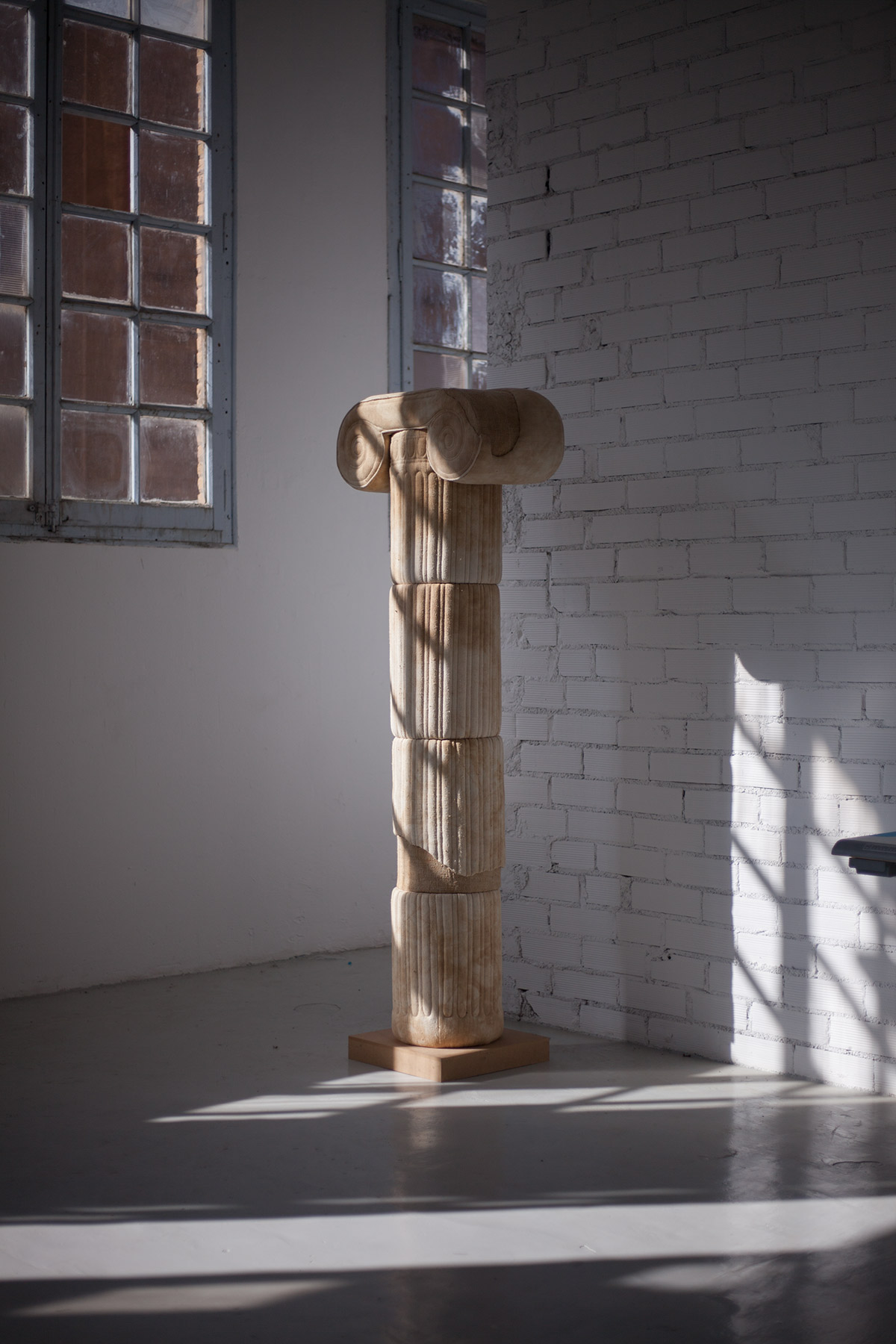
Have you explored other materials such as stone or ceramics, in addition to textiles or soft sculpture?
Even though I’m interested in it to some extent, I wasn’t particularly skilled at traditional clay sculpting. But gradually, I’ve started introducing other materials to my current practice. Let’s say I haven’t been trained as a sculptor in the traditional sense. There has always been something very natural in how I relate to textile material; it’s almost automatic. As soon as I start working, it’s as if my hands move on their own. I also like the fact that sewing allows me to take a step back and easily correct mistakes. Then there’s that familial connection to textiles, which I suppose is hereditary. But no specifically in the Fine Arts.
You mentioned a family connection. Has your family been involved in the textile industry?
Yes, there is a family connection, but I haven’t personally experienced it because it mostly happened before I was even born. My father was the last generation of a family business in the textile industry that was started by my great-great-grandfather in the 18th Century in a village not far from Barcelona. The factory closed when I was very young, which is why I never got to experience it. I hadn’t even connected my work with my family history until recently when I was talking to my father’s older sister. She told me that the family factory was in an area where there used to be a significant textile industry. The interesting part is that as far back as the 15th century, a family from the Netherlands settled in this region of Catalonia with the surname Roger, and happen to be my ancestors. They were wool producers and began textile production here. I don’t know; I find it super interesting, and I’d like to explore this further. Sometimes, what seems intuitive or accidental turns out not to be, and there’s an invisible memory that emerges. There’s a connection that comes through my work, and I imagine everything falls into place. Additionally, it’s beautiful to feel like you’re preserving a family legacy by reviving a family tradition.
It’s as if you’re picking up the germ of that tradition, the fabrics, and transforming them into works of art.
Yes, I remember a conversation I had with my grandfather in the final moments of his life. We were with the family, and I showed them one of the video-art works I made when I was still at the Fine Arts University. I recall him looking at me in awe; he didn’t understand any of it. Older generations tend to have a different interpretation of things. My grandfather had a rather humourless sense of humor, and after watching the video, he said with a grin, ‘On his gravestone, it will say ‘he never did anything’. That really hurt when he said it just before he passed away, but over time, I made peace with it and trough my work I feel even more connected to him than ever.
Tell us a bit about why you choose this classical era with a neoclassical, Greco- Roman style. Do you have a particular love for history, or is it purely aesthetic?
Well, classical art is one of the great themes in art history, revisited throughout all subsequent periods. Almost all of my work is done in a very intuitive way, and this also happened almost by accident. One day I brought a classical plaster bust into the studio and said, “Let’s do this!” I challenged myself to reproduce the classical ideal of beauty through textiles. As I delved deeper into this world, there are a series of discourses and themes that fascinate me about Greco-Roman art. I believe that in the latest pieces I am working on, the aspect of ruins is very well reflected. I am interested in questioning and investigating how we relate to archaeological objects, which serve as carriers of information from that era. How we construct a narrative through an object that is actually filled with absences and speculations about what it once was. A narrative that was built during the 19th century, coinciding with a Eurocentric approach, which also coincided with colonialism. Let’s say that my latest pieces reflect both the emotional and very romantic side, but there’s also the intellectual aspect that interests me greatly: how they engage in dialogue or question, I seek all of that effect.

There’s a touch of humor or perspicacity in your work that brings a smile when you see it.
In a way, there’s a sense of humor and irony. The material itself leads you in that direction. Some of my pieces have that more ironic look. Usually, all artists working with textiles, reinterpreting an object, tend to lead you towards the idea of irony and humor, to lighten things up and add a touch of playfulness. But in my case, it’s also about taking the piece to a point where there’s a certain level of technical excellence. It comes to me naturally, but what I’m aiming for sometimes can be close to haute couture.
It’s quite different from your previous project, “Softheads,” which was a commercial product.
“Softheads” had a more direct sense of humor. It was a project from which I learned in many fields, such as pattern making, technical aspects, business management, and teamwork. I’m still collaborating with two of the team members on this project. Thanks to “Softheads,” I’ve learned and grown over the years, but I’ve now closed that chapter.
We’re in your new studio, located in an industrial space of an old textile factory, which is quite different from the one you had in the heart of Barcelona – a 19th- century neoclassical house where your sculptures blended perfectly with the ornate walls and ceilings. Was this change out of necessity, or did you simply desire a change of scenery?
Yes, I recently moved here. I was looking for a space where I could work more privately, use it as a warehouse, and create larger pieces. This space allows me to experiment freely, work in silence, and I don’t have the distractions of the city. I still maintain the Barcelona studio, where me and my assistants work on smaller pieces like the busts, and it also serves as a showroom.
I imagine one of your favourite places to find inspiration is in museums of ancient art.
Absolutely, for me, they are the Mecca of inspiration. In fact, I recently discovered what has become one of my favourite museums, which is conveniently located near my studio in Barcelona – the Frederic Mares Museum. He was a sculptor from the late 19th century, but above all, he was a great collector specialising in sculpture. In this palace, you can find Roman and Iberian pieces, medieval wood carvings, rooms filled with Romanesque and Gothic Christ figures, and medieval sculpture. It’s a delight, and you must visit it.
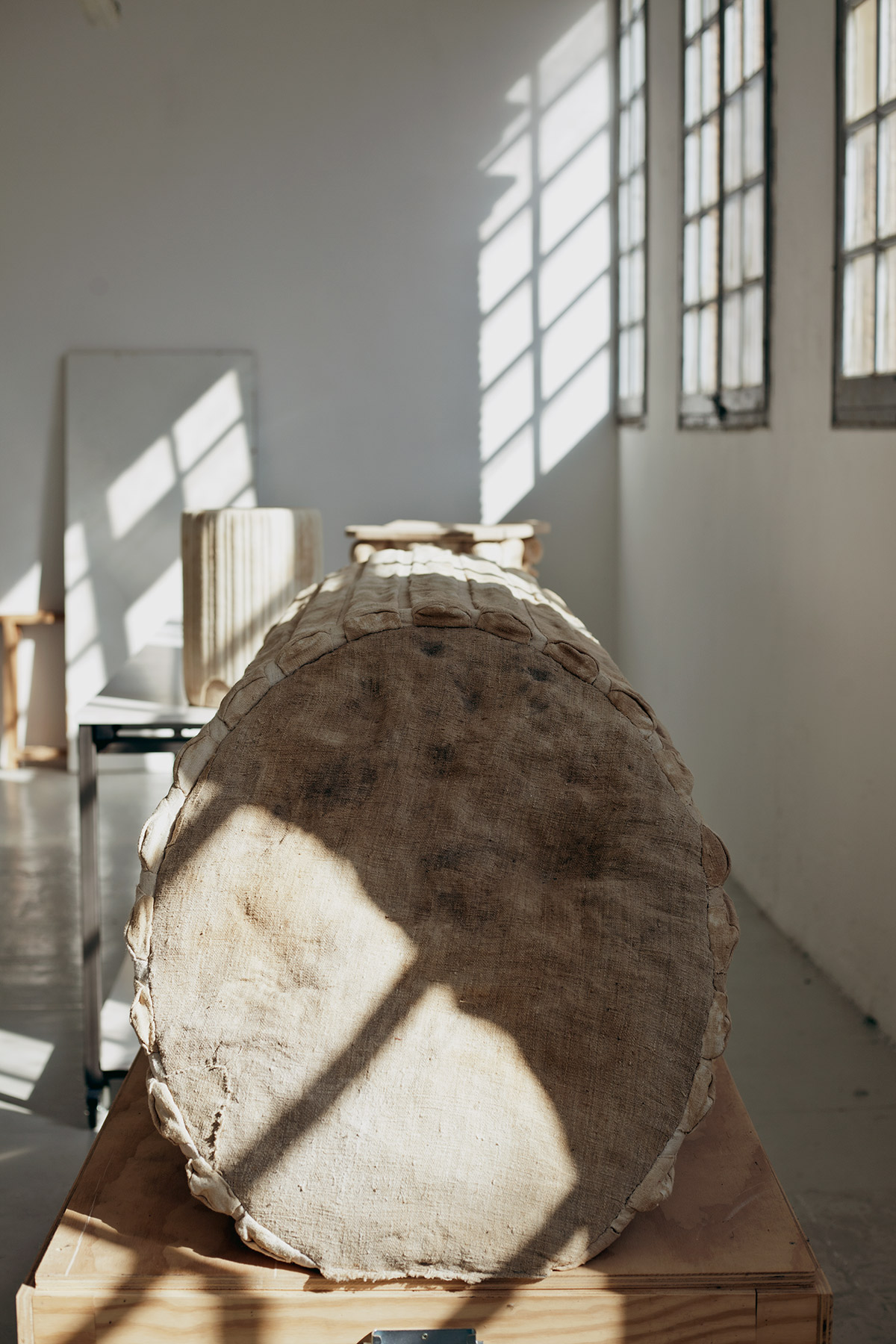
Will we see a transition in your representation from ancient art to a more medieval one?
Perhaps not in a literal sense, but from a more symbolic or abstract perspective. I’m not sure if I’ll be making literal reproductions of Christ, but there’s something about that era that attracts me. In fact, I still keep a small stuffed soft Christ on a cross that I made when I was young.
Outside of ancient art and your sources of inspiration, do you engage with abstract or contemporary art, or do you not feel attracted to it?
Yes, of course! I’m fascinated by contemporary art, sculpture in all its forms, as well as installations and objects. Painting mostly interests me when it breaks away with its conventional format and moves beyond the canvas. Regarding the choice between figurative and abstract, I must say that I see a lot of abstraction in ruins, and many of the classical pieces that fascinate me are like contemporary abstract art due to their fragmented nature.
You work with fabrics, especially linens, some of which are over a hundred years old. You’re not afraid of depleting all the stocks of linen from that era. Can you explain what these fabrics bring to your work and whether you also use other types of textiles like cotton, silk, or leather?
Hahaha, that would mean I’ve done exceptionally well. Well, it’s not easy to find; I have different sources, private and some antique textile dealers. I love the fact that there is always some storytelling connected to each fabric: its precedence and how it ends up in my hands. I usually work with antique fabrics because their texture reminds me of stone and also because they have a special patina. The craftsmanship behind each fabric makes each piece unique and beautiful. Moreover, linen is a fabric that was part of the classical world and connects my work with this era. But I’m also experimenting with other fabrics like leather. I love watching videos of upholsterers who restore antique cars beause their technique is very similar to mine. Eventohough I would describe my style as a mix of upholstery and “haute couture”. In one of my projects I also used silk to create a series of Exo-columns.
For te first time this columns had no inner structure. They were completely soft and they stood up with the help of some sort of scaffolders or prosthetics. This work disrupts the typical function of a column or pillar.
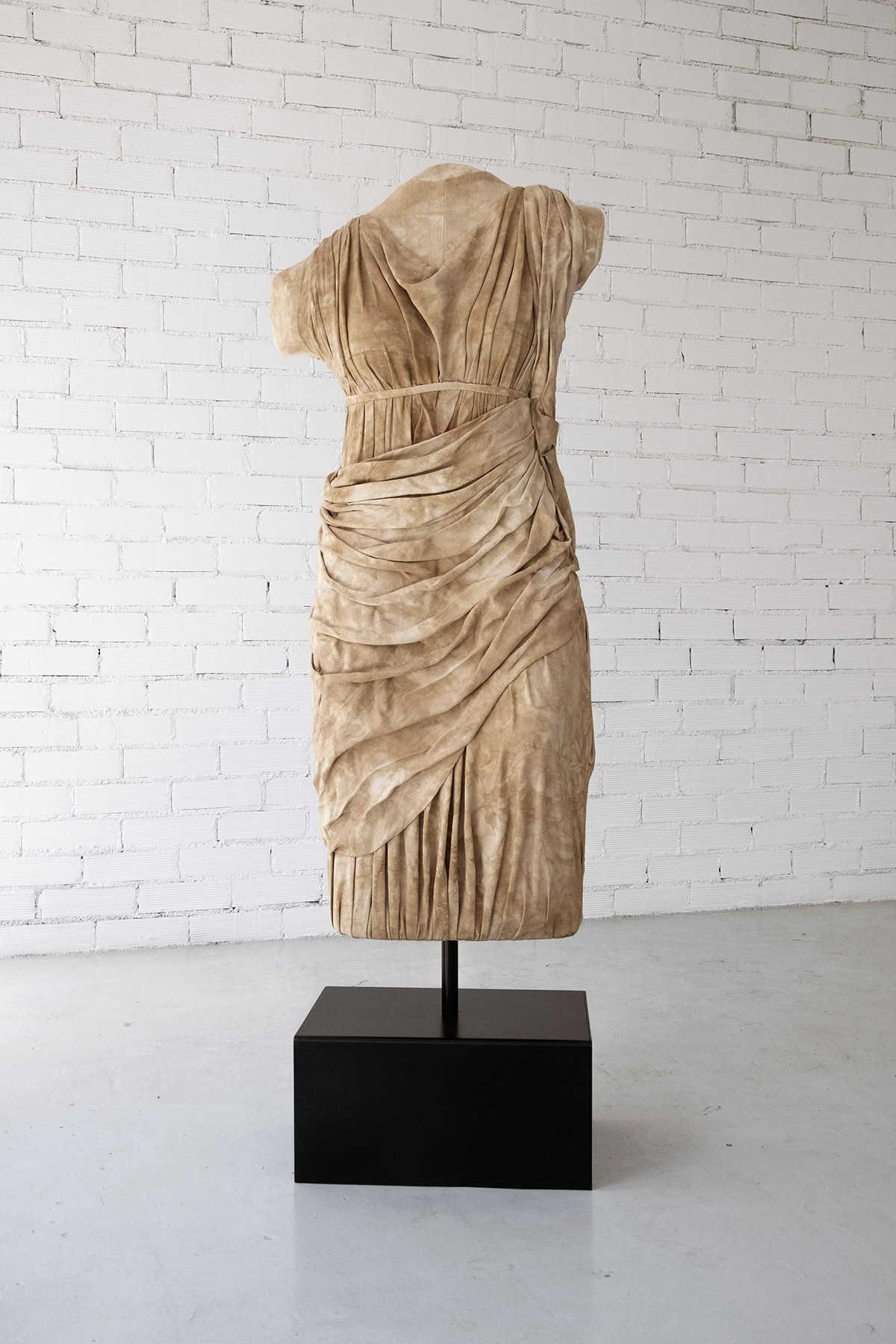
Do you have a piece that holds a special place in your heart compared to the rest?
It’s hard for me to talk about one piece in particular because they all come from an obsession I had at that time, something I wanted to develop, and I always grow very attached to them. Then comes the time to part with them, but that’s a normal dynamic, and luckily I always keep photos. However, it’s true that having certain pieces in the studio, like the coloured silks, gives me a boost of energy having them close by. I love having a colourful piece in the studio.
What projects are you currently working on?
Its been a very busy Autumn. After the collaboration with Hermès last September and presenting a large installation at Frieze Masters in October in London, I am pre- paring currently a solo show in Rome with the gallery Spazio Nuovo for November.
Do you have any family members who help you with the finishing touches on your pie- ces on Sundays, like your grandmother or any of your parents?
Well, both my grand- mother and my mother are very artistic; they also have a fascination with textiles. My mother knits, and my grandmother does petit point, like cross-stitching – she makes the- se super intricate pictures with all the wool pixels and takes two years to complete a pie- ce. But that technique doesn’t really help me. I’m more interested in the world of upholstery, and it’s a shame because it would be cool to involve them in a project. In fact, now I want to start using embroidery for a piece I’m working on for an exhibition in Rome, and maybe they could help with that.
Your sculptures have been acquired by major galleries in London, Milan, and private collectors. How do you feel about this recognition?
Honestly, everything has happened very quickly and in a very unexpected way. I feel tremendously thankful about how much I am growing and learning during this process. Since I was very young I dreamed of becoming a profesional artist. But it first happened around my 40s and after a very long journey. I believe that being true to my work and abilities has led me to where I am now. After art school, I followed the standard path that an artist should follow: residencies, having a commercial gallery etc. Tired of struggling I decided to take a break and try different things in order to make a living. After having a break of a few years I returned to art from a very honest place. I just wanted to make art no matter what. For my surprise, very prestigious personalities and institutions started to show interest in my work such as Rossana Orlandi in Milan, Christie’s in London etc. After that everything started to speed up incredibly fast.
